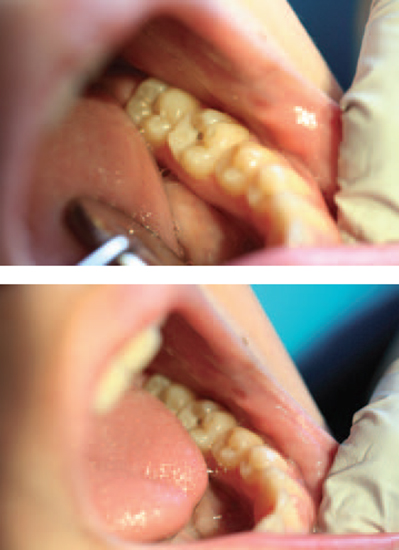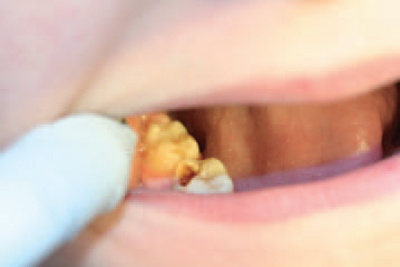SECTION 5
TOOTH RESTORATION WITH FILLINGS

REASON FOR PROCEDURE
When a tooth is attacked by caries, a process of demineralisation occurs in the hard tissues of the tooth, starting in the enamel outer layer. This opens up the inner dentine layer to infection by the bacteria involved in caries and, as this layer contains nerve endings, the patient will feel hot and cold sensitivity and eventually pain. Once painful, there will be a loss of function as the patient avoids chewing with the affected tooth.
The caries attack will progress further into the tooth until it reaches the pulp chamber, eventually causing an abscess and the death of the tooth, unless the tooth is dentally treated by filling (see Figure 5.1a, b).
A tooth may also require a filling if it fractures, whether or not caries is involved, as a fractured tooth may also become sensitive to hot and cold, or cause soft tissue trauma to areas within the oral cavity (see Figure 5.2).
The purpose of the filling procedure is ultimately to restore the tooth to its normal function, and this will involve the elimination of any caries first, as well as the elimination of any discomfort or pain experienced by the patient.
The procedures to be discussed are:
- Amalgam fillings
- Composite fillings
- Glass ionomer fillings
AMALGAM FILLINGS
Background information of procedure
Amalgam is a metallic material used for fillings, produced by the mixing of an alloy powder (containing mainly silver) with a small amount of liquid mercury. This produces a plastic material that can be inserted fully into the tooth cavity and then carved to the shape of the tooth surface. Once set, it forms a solid plug in the cavity that is hard enough to chew on, as well as sealing the tooth’s sensitive inner layers from further exposure to hot and cold stimulants.
Figure 5.1 (a, b) Caries in lower first molar

Figure 5.2 Fractured carious tooth

As the material is metallic in appearance, it tends not to be used for anterior fillings, as far more acceptable aesthetics are produced here using tooth-coloured filling materials.
Details of procedure
The procedure is normally carried out under local anaesthetic, so that the patient feels neither pain nor thermal stimulation in the tooth. The effects of the local anaesthetic will wear off after several hours, by which time the dental treatment will have been completed painlessly.
During the procedure, a dental nurse provides good moisture control in the oral cavity using high-speed suction equipment, so that the dentist has a clear field of vision at all times. The suction equipment is used to remove saliva, debris from the tooth and water from the dental handpiece that cools the drill whilst in use.
Technique
- The dentist, nurse and patient wear personal protective equipment for safety reasons; this usually consists of goggles and mask for the dental team, and a protective bib and safety glasses for the patient
- Local anaesthetic is administered and allowed to take full effect
- All caries is removed from the tooth cavity using a combination of high- and low-speed dental handpieces with drills, and cutting hand instruments
- This produces a firm tooth cavity surface into which the filling can be placed, which is then undercut to prevent loss of the completed filling
- Depending on the depth of the finished cavity, a protective lining may be placed over the base so that the pulp beneath is not exposed to thermal irritation through the metallic filling
- If more than one tooth surface has been destroyed by caries, a metal matrix band is placed around the tooth and tightened to allow the amalgam to/>
Stay updated, free dental videos. Join our Telegram channel

VIDEdental - Online dental courses


